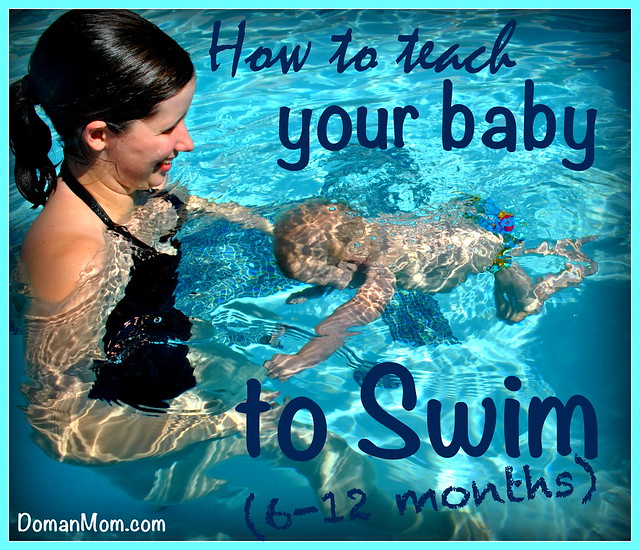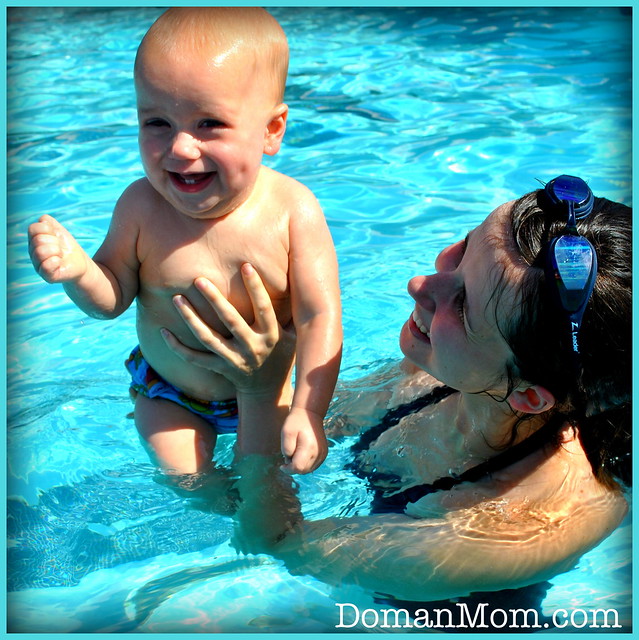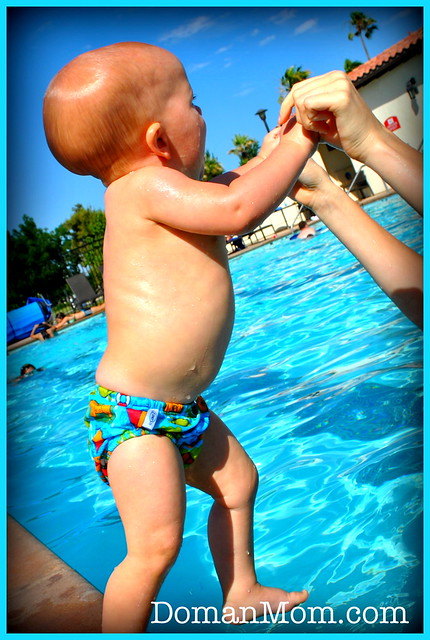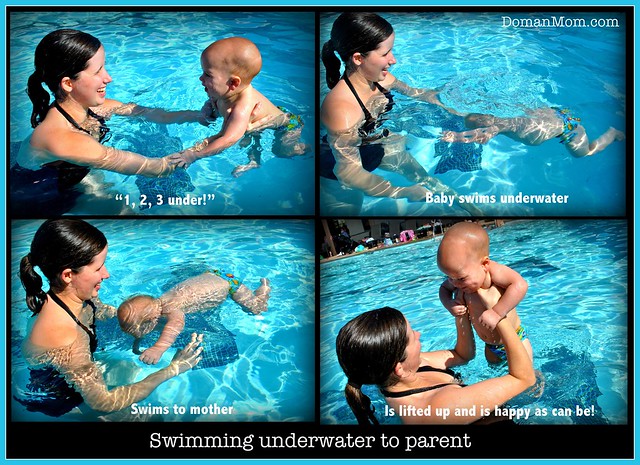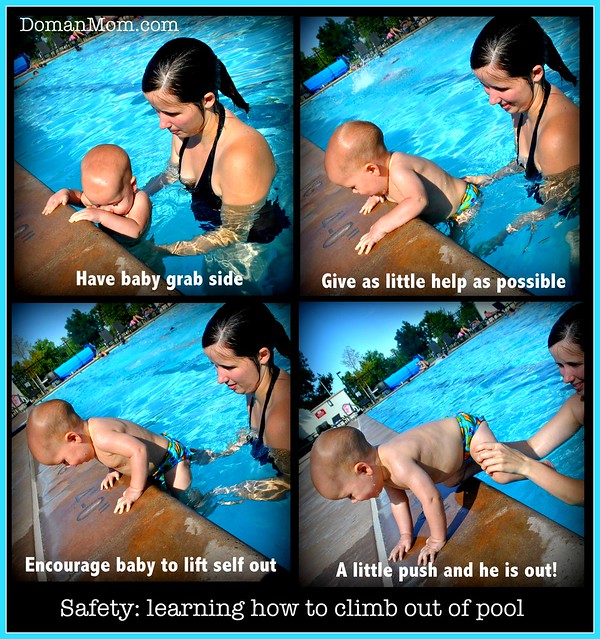Summer officially began yesterday, but for many of us “summer” has been in swing for weeks or even months now, which hopefully means lots and lots of beneficial swimming!
Our swimming program has been on again, off again since April, but lately has been going great with fabulous progress from both of my boys (ages 1 and 7). In this post, I would like to share with you the exercises I have been using with Damien (12 months) over the past few weeks to teach him how to swim!
I use the techniques as outlined in the Doman book How to Teach Your Baby to Swim – Birth to Age 6. A little about this program:
- It is not just a “water introduction” program as most “swimming lessons” are for this age. It is actually about teaching your baby to swim, by themselves, beginning at birth or any time thereafter (newborns are born knowing how to swim).
- The program is gentle and joyous! No aggressive, cry-it-out techniques here.
- The program emphasizes learning swimming skills, water safety, water hygiene, and bonding with parents.
This 6-12 month old program is the second level of the Doman swimming program (first level is 0-6 months). Some prerequisites to this level of the program:
- Is ideally familiar with and accustomed to water and pool.
- Can hold breath underwater
There are a lot more things covered in the first level of the program, but if you have an older baby and are just now beginning, you can jump right into this level of exercises after you first work on getting your baby comfortable in water and knowing how to hold their breath underwater. Some tips for achieving that are found below!
Are you ready for the techniques? Here are some of the exercises we do:
1. Jumping into the pool
This is an important exercise as it is not only laying the foundation for diving later on, but you are also teaching your baby how to safely enter the pool. It’s also an awful lot of fun!
Key: Teach baby to only enter pool with parent!
You can do this exercise by first having baby sit at the edge of the pool. Teach him that mommy always goes in first and he must wait. They’re never too young to understand this!Once you are ready, give him permission – “Ok! 1,2,3, jump!” Whatever wording you choose, be consistent and always say that same phrase.
In the beginning you will need to have him hold your fingers with his hands and very gently pull him in. If he is accustomed to going underwater, let him jump in and go under and then pull him up to the surface or let him kick and swim up to the surface.
Beginners: If he’s not yet accustomed to going underwater, just let him go in chin deep and then pull him back up to yourself. Gradually go deeper under as he learns and becomes comfortable!
Some alterations of this exercise:
- Jump in from sitting without holding parent’s fingers
- Jump in from standing position with or without holding parent’s fingers
Tip: Continue to hold your baby’s fingers until you feel he is very well balanced – slipping is easy and can be dangerous
2. Blowing bubbles, bobbing up and down, going underwater together
Blowing bubbles in the water is a great way to teach your baby to hold his breath if he’s not yet accustomed to it. It will teach him to blow out, not breath in, while his mouth is underwater, and will also help him to get comfortable with his face in the water. Babies love to mimic so this is always a lot of fun!
Bobbing up and down is another way to slowly introduce your child to holding his breath. Think of a phrase to use, such as “1,2,3, under!” that means he is about to go under the water, and use it every time without fail!
Always tell your baby when he is about to go under (either a little or fully submerged). He will learn what the phrase means and will hold his breath in anticipation.
At first simply bob him up and down only to chin deep. Keep it fun and joyous! Gradually, over the course of time, get deeper and deeper, first getting just his mouth a little wet with each bob, then submerging his entire mouth, then up past his nose, finally you will get to where his entire face and then entire body goes under with each bob.
Read your baby’s cues – introduce steps gradually and don’t continue if your baby isn’t enjoying himself!
A final exercise in learning to hold his breath will be to go underwater together completely. Do this for just a split second at first and you will gradually be able to stay under longer. Make it fun!
3. Passing underwater
Once your baby is comfortable holding his breath underwater, you can begin to teach him the swimming motions by passing him under the water. Grasp his sides as in the picture above and hold him horizontally in the water. You can either hold him straight out in front of you (as above) or sideways in front of your, or by your side. Then give him to phrase (“1,2,3, under!”) and put him underwater while moving him through the water. Encourage him to kick, kick, kick! This will teach him the forward motions of swimming. As he gets used to this, briefly let him go while you do this exercise.
4. Swimming independently underwater
Once your baby is comfortable and confident underwater, he can begin to truly swim! Start by doing the bobbing up and down exercise or the passing underwater exercise, but briefly let go of him while he is underwater. This may startle him at first to feel his own weight floating in the water without your hands supporting him! Just begin slowly and gradually, as with everything.
Next begin to walk backwards in the pool while holding baby by his sides in front of you(see above picture). Give him the signal that he is about to go under (“1, 2, 3, under!”) and let him go. Hold your arms out for him to swim to you. Babies instinctually know how to swim! He may be uncoordinated at first but will get the hang of it quickly.
If he doesn’t fully swim to you, pull him towards you and then lift him out of the water.Praise him profusely! Begin with just split second swim sessions and gradually lengthen the time baby stays underwater as you sense his capabilities.
Walking backwards before you let him go under creates a current and will make it easier for baby to swim to you!
Alterations of this exercise:
- Have baby swim to you while you are standing still (instead of walking backwards first)
- Have baby swim between two parents or between a parent and sibling
- Have baby swim in front of you or beside you (this way you can “push” him through the water before letting him go, giving him a boost)
- Have baby sit on a stair step or hold onto the ladder or edge and then jump in and swim to you
5. Floating on back
By being able to float on their backs, babies can learn to swim, flip over to catch a breath(and/or rest), swim some more, and then catch another breath and continue in this pattern. Most babies will be able to float on their backs long before they are able to lift their heads out of the water.
This exercise is simple – put your baby on his back and help him float! At first hold your baby completely so he feels secure, but gradually decrease the amount of support you give him until eventually he will hopefully be able to float on his own. If baby is uncomfortable in this position at first, you might need to get creative – for instance, lay your baby’s head on your shoulder (at water level) and be playful – have him kick his feet and tickle his tummy! He will gradually become used to the horizontal position.
Try associating a song with back floating – we sing “Twinkle, twinkle little star” (as he looks at the sky). Consistently using specific words, phrases, or even songs for each exercise will teach your baby what to expect and spur his success.
Alterations of this exercise:
- It is a good idea to teach your baby how to get on their backs from a different position. Flip them gently from their stomach to their back, then back onto their stomach, etc.
- Help your baby to swim to the surface of the water and then get into the back floating position.
On a side note, my son hates floating on his back! The child is all smiles the entire time we’re in the pool but becomes very upset whenever I try this with him. I just introduce it in short little bursts and don’t push it when I see he is not enjoying himself. I know, as with everything, he will get it eventually.
6. Safely exiting the pool
It is very important that your baby learn how to climb out of a pool. Have baby grab the edge of the pool and let him hang on with as little support from you as possible. Let him hang there for a little while. The goal will be to be able to swim to the edge and hang on by himself, and then to eventually be able to hang on and climb out of the pool.
After he has held onto the edge for a little while, tell him to climb out. Give him a little push or let him push off of your hands as needed, by try to let him do as much as possible by himself.
Alterations of this exercise:
- Swim to a ladder and climb out the ladder
- Swim to the stairs and climb out from the stairs
- If you’re in a lake, pond, or ocean, have him swim to the edge of the water and crawl or walk out, or have him hold onto the edge of a dock or climb out a dock ladder
Remember:
1. Always, always, always supervise your baby.It doesn’t matter how good of a swimmer they are – they need adult supervision at all times. Do not become complacent thinking that your baby can save themselves if they fell in. Ever. You need to have the same (or more) vigilance as if they had never seen a pool a day in their life. Drowning is a leading cause of death in young children and 85% of these deaths were completely preventable with proper supervision.
2. Strongly emphasize from day one that baby may never, never enter the pool without you first giving the signal and being right there. Be consistent and they will learn.
3. Be joyous in your teaching! Your baby will pick up on your attitude. Always be enthusiastic, happy, and full of laughter and excitement, even if your baby might be timid. Babies will feed off of your composure.
4. Watch your baby carefully for distress, and never push him beyond slight discomfort. The key is to be gradual and patient. If he does not like something, do the exercise for just a split second and then praise him profusely. Hug him, kiss him, tell him how wonderful he is, and celebrate his accomplishment. Perhaps repeat one more time, then go onto something else. A little bit every day leads to substantial progress over time.
5. If your baby does not enjoy the water at all, do not try and do these exercises until he is comfortable in water. Start small, just by getting him used to walking around in the water while you hold him. Encourage him to splash, watch you get your face wet or blow bubbles, or play with toys. Once he is comfortable, gradually build in more exercises into your routine. The bathtub is also a great place to introduce splashing, bubble blowing, floating on back, and getting their faces a little wet while you rinse them off.
6. Try to swim at least three days a week to achieve the best result. Swimming every day is ideal!
As some encouragement for you, here is a video of my baby I took two days ago of him swimming underwater. If it makes anybody feel better, just a few weeks ago he hated putting his face in the water and would often swallow water whenever I put him under!Now he swims with great joy and even since this video, he has progressed! He now kicks his little feet and swims farther and longer underwater, and he also no longer nose dives to the bottom of the pool but stays relatively near the surface!
Happy swimming! I would love to hear about your experiences and progress with your little ones!
See also, my response to the many queries in the comments about the ISR method for infant swimming: Infant Swimming: The Roll and Float Survival Method (ISR)
Also related: Video and pictures of Damien swimming at 21 months old – Toddler Swimming: Water Play
“The LORD on high is mightier than the noise of many waters, yea, than the mighty waves of the sea.”
Psalm 93:
